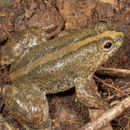Distribution
provided by Amphibians and Reptiles of the Philippines
This species is incredibly common and widespread throughout the Philippine archipelago.
Faunal Affinity
provided by Amphibians and Reptiles of the Philippines
Found throughout the Philippine islands.
Type Locality
provided by Amphibians and Reptiles of the Philippines
Description
provided by AmphibiaWeb articles
Description: Occidozyga laevis is a squat and stocky ranid. The SVL reaches up to 31 mm for males and 48 mm for females (Inger and Stuebing 2005). The body is stout with a small head (Alcala and Brown 1998). The skin of the dorsal surfaces is corrugated with rounded protrusions (Inger and Stuebing 2005). Legs are very muscular and short with fully webbed toes (Alcala and Brown 1998).Diagnosis: Adults of this species resemble young Limnonectes kuhlii, but can be distinguished by having an interorbital distance equal to or less than the width of the eyelid (The interorbital distance is greater than the width of the eyelid in L. kuhlii), and by having a single tooth-like projection on the lower jaw (a pair is present in L. kuhlii) (Inger and Stuebing 2005).Coloration: The ground color is dark gray-brown. The ventral side of the head is a speckled dark gray and a yellow tinge is sometimes present on the venter and undersides of the thighs (Inger and Stuebing 2005).Variation: Some individuals may have a thick light stripe down the dorsum (Inger and Stuebing 2005).Tadpole Morphology: Tadpoles are small and slender, reaching a total length of 25 mm, with the tail length greater than two times the body length (Inger and Stuebing 2005). Tadpoles have tubular mouths and lack teeth (Alcala and Brown 1998). The body has dark spotting, along the fin margins (Inger and Stuebing 2005).Species authority: Günther (1858) (Frost et al. 2011).
- Diesmos, A., Alcala, A., Brown, R., Afuang, L., Gee, G., Sukumaran, J., Yaakob, N., Ming, L. T., Chuaynkern, Y., Thirakhupt, K., Das, I., Iskandar, D., Mumpuni, Inger, R., Stuebing, R., Yambun, P., and Lakim, M. (2004). Occidozyga laevis. In: IUCN 2010. IUCN Red List of Threatened Species. Version 2010.4. www.iucnredlist.org. Downloaded on 31 March 2011.
- Gray, L. A., O'Reilly, J. C. and Nishikawa, K. C. (1997). ''Evolution of forelimb movement patterns for prey manipulation in anurans.'' The Journal of Experimental Zoology, 277, 417-427.
- Zainuddin, R. (1999). ''A brief note on frogs of Bario, Kelabit Highlands, Sarawak.'' ASEAN Review of Biodiversity and Environmental Conservation (ARBEC), September-October, 1-5.
- author
- Christine Isabel Javier
Distribution and Habitat
provided by AmphibiaWeb articles
O. laevis is distributed widely in Southeast Asia, at elevations up to 1200 m asl. This frog is found in a range of habitats, from polluted puddles and marshes to clear mountain streams. In peninsular Southeast Asia, it is found near forest streams, in shallow muddy puddles. This species inhabits forested areas, but not disturbed areas. In the Philippines, it can tolerate some disturbed habitat. It also inhabits some pristine lower montane and lowland forests (Alcala and Brown 1998; Diesmos et al. 2004). In Borneo, this species is abundant in muddy wallows and small streams (Zainudden 1999).
- author
- Christine Isabel Javier
Life History, Abundance, Activity, and Special Behaviors
provided by AmphibiaWeb articles
This species is active both diurnally and nocturnally. O. laevis is primarily aquatic, submersing its entire body in the water except for its snout and eyes (Alcala and Brown 1998). It is oviparous and has aquatic larvae. O. laevis has unusual forelimb movement for a frog. O. laevis catches and moves its prey by extending its forelimbs, fingers splayed, and scooping the prey towards its mouth (Gray et al. 1997).
- author
- Christine Isabel Javier
Life History, Abundance, Activity, and Special Behaviors
provided by AmphibiaWeb articles
O. laevis can tolerate some human disturbance and the populations currently do not show a great degree of disturbance. However, the populations could suffer habitat loss from its most likely threat, deforestation (Diesmos et al. 2004).
- author
- Christine Isabel Javier
Common puddle frog
provided by wikipedia EN
The common puddle frog, puddle frog, or yellow bellied puddle frog (Occidozyga laevis) is a species of frog in the family Dicroglossidae. It has often been confused with Occidozyga sumatrana (which until 1998 was considered to be a junior synonym O. laevis[2]), and records of this species outside the Philippines likely represent that species.[3]
Range
The common puddle frog is found in peninsular Thailand (including Phuket), Malaysia, Singapore, Borneo, Anambas Islands (Tarempah), Riau Islands (Natuna Besar), and the Philippines.[1]
Habitat
Its natural habitats are tropical moist lowland forests, rivers, intermittent rivers, swamps, intermittent freshwater marshes, coastal freshwater lagoons, arable land, pastureland, rural gardens, urban areas, water storage areas, ponds, aquaculture ponds, irrigated land, seasonally flooded agricultural land, and introduced vegetation.[1]
References

- license
- cc-by-sa-3.0
- copyright
- Wikipedia authors and editors
Common puddle frog: Brief Summary
provided by wikipedia EN
The common puddle frog, puddle frog, or yellow bellied puddle frog (Occidozyga laevis) is a species of frog in the family Dicroglossidae. It has often been confused with Occidozyga sumatrana (which until 1998 was considered to be a junior synonym O. laevis), and records of this species outside the Philippines likely represent that species.
- license
- cc-by-sa-3.0
- copyright
- Wikipedia authors and editors

